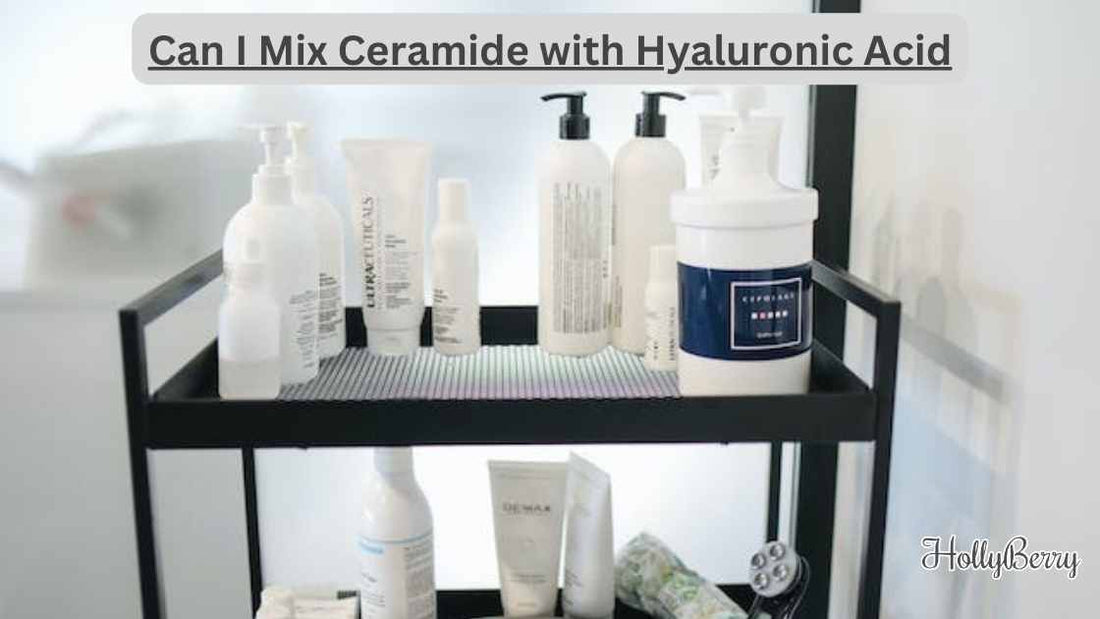
Can I Mix Ceramide with Hyaluronic Acid
Share
Unveiling Skincare Synergy

Ceramide and hyaluronic acid are both well-regarded ingredients in the skincare industry, valued for their restorative and hydrating properties.
The use of ceramide is synonymous with reinforcing the skin's natural barrier, thereby aiding in the retention of moisture and providing a defense against environmental aggressors.
On the other hand, hyaluronic acid is revered for its ability to draw in and hold water, significantly enhancing skin hydration and reducing the appearance of fine lines and wrinkles.
The question arises as to whether these two powerhouse ingredients can be mixed and used concurrently in a skincare routine.
While ceramide works to fortify the skin's defences, Hollyberry Cosmetics hyaluronic acid serves to ensure that the skin is thoroughly saturated with moisture.
Their differing roles may suggest they can be paired to create a more comprehensive skincare regimen that both protects and deeply moisturises the skin.
Skincare experts generally agree that combining ceramide with hyaluronic acid can be highly beneficial.
This synergy allows for the enhancement of the skin's moisture levels while simultaneously strengthening its protective barrier, which can lead to improved skin health and appearance.
The compatibility of these ingredients means that they can be used together safely to achieve hydrated, resilient skin.
Understanding Skincare Synergy
In the pursuit of healthier skin, the combination of ceramide and hyaluronic acid has gained popularity for their complementing roles in skin hydration and barrier function.
Ceramides and Hyaluronic Acid in Skincare
Ceramides are lipid molecules found naturally in the skin's epidermis. They play a crucial role in maintaining the skin barrier and retaining moisture.
Hyaluronic acid, on the other hand, is a hydrophilic molecule that attracts water to the skin, thus aiding hydration and giving the skin a plump appearance.
When used together, these two components effectively boost the skin's moisture levels and fortify the skin's natural protection against environmental stressors.
- Ceramide: Essential lipid in the skin's barrier, preventing moisture loss.
- Hyaluronic Acid: Naturally occurring substance that holds up to 1000 times its weight in water, increasing skin's moisture content.
Skin Barrier and Moisture Retention
The skin barrier, primarily comprised of corneocytes, fatty acids, and a mix of lipids including ceramides, is the frontline defence against external irritants and moisture loss.
Hyaluronic acid contributes to the moisture retention in the dermis layer, supporting the barrier function. Their synergistic action results in a reinforced barrier and enhanced moisture retention, leading to healthier and more resilient skin.
- Skin barrier composition: Corneocytes, lipids (ceramides, cholesterol, free fatty acids).
- Moisture Retention: Hyaluronic acid augments the ceramide function by maintaining hydration within the dermis and epidermis.
Application and Product Selection
When considering the addition of ceramides and hyaluronic acid to a skincare routine, it is crucial to select the right products and understand the most effective application methods.
These ingredients can be found in serums, cleansers, and moisturisers, each offering unique benefits.
Incorporating Ceramides and Hyaluronic Acid into Routine
Ceramides and hyaluronic acid are both naturally occurring substances in the skin, revered for their hydrating and barrier-reinforcing properties.
Skincare aficionados can find these ingredients in a range of products, from intensive serums to nourishing moisturisers. When integrating these substances into one's skincare regimen, a typical routine could follow this order:
- Cleanse: Begin with a gentle cleanser to remove impurities, setting a clean base for product absorption.
- Serum: Apply a serum containing hyaluronic acid to damp skin for optimal hydration.
- Moisturiser: Follow up with a ceramide-rich moisturiser, which locks in moisture and strengthens the skin's natural barrier.
When pairing ceramides with other skincare ingredients like niacinamide, retinol, or vitamin C, it is important to layer them correctly. Here is an example breakdown:
- Cleanser: Should be gentle and pH-balanced to avoid disrupting the skin’s acid mantle.
- Vitamin C Serum: Best applied in the morning to help with skin brightening and protection against environmental stressors.
- Hyaluronic Acid Serum: Can be used morning or night for deep hydration.
- Niacinamide: A versatile ingredient often found in serums and moisturisers which can support the effectiveness of ceramides.
- Retinol: Typically used in the evening; wait for the skin to dry before application to reduce potential irritation.
- Ceramide-enriched Moisturiser: To seal in all prior treatments and fortify the skin barrier.
It's important for individuals to patch test any new product and introduce only one new product at a time, to monitor skin’s reaction.
Those with specific skin concerns may benefit from consulting a dermatologist to ensure that products containing ceramides and hyaluronic acid fit seamlessly into their existing skincare routines without adverse effects.


1 comment
Hello
I’m looking for dry skin products
But it’s look all products are for all skin